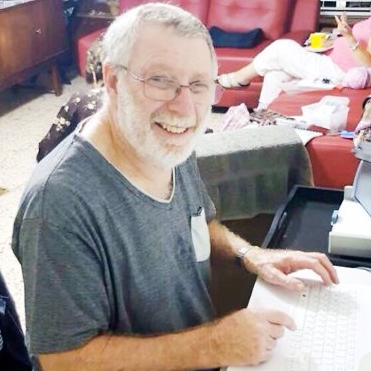
SA

What’s in a street name?
MOIRA SCHNEIDER
Ex-South African Peter Bailey, who made aliyah from Johannesburg with his wife, Jeanne, in 2013, has written a book on the very topic called Street Names in Israel. In it, Bailey presents a series of biographies that detail the background to many of the street names commonly found throughout Israel. He and Jeanne left to join their three sons, along with their wives and six grandchildren in Israel.
The book was launched at the Jacob Gitlin Library in Cape Town last month. Bailey, who grew up in Brakpan and now lives in Hod Hasharon, did painstaking research on the street names. He is a former national chairman of the SA Jewish Ex-Service League, having served as a major in the old SA Defence Force.
Bailey says he was motivated to write the book by sheer curiosity. “I actually discovered that a lot of people in Israel know all these streets that they pass every day, but they didn’t really know who the people were that the streets were named after.
“I felt there was a need to educate people about who these people are, so that their deeds live on.”
Bailey realised that Israel’s history was reflected largely in its street names, and since Jewish history is one of his passions, putting it all in a book was a no-brainer. The book took three years to write.
Objects, places, organisations and events of significance to the Jewish people throughout their history have a separate chapter dedicated to them – after the listing of individuals.
Maish Isaacson, chairman of Telfed, writes in the foreword that the book “unlocks the sizzling stories of many individuals involved in the Zionist movement and in founding the fledgling State of Israel”, and contains “many surprising revelations of Jewish history”.
“It gives us a voyeuristic glimpse into the lives of people from all walks and professions that have left an indelible mark on our nation,” he adds, “… introducing you along the way to spies, agronomists, authors and heroines.”
Speaking of spies, we meet Rumanian-born Aaron Aaronson (1876-1919), an agronomist and spymaster. In 1882, he made aliyah with his parents.
As an adult, he lived on a farm which became the centre of activities for NILI, an espionage organisation that he and his assistant, Avshalon Feinberg, had set up to spy on behalf of the British during World War I.
Bailey writes: “He was able to compile maps and information on troop displacements. This information assisted the British commander, General Allenby, to mount the surprise and highly successful attack on Beersheba.”
Aaronson died in an aircraft accident in 1919.
Aaron Aaronson Street is found in Zichron Yaakov, Hadera, Netanya, Hod Hasharon and Kiryat Ono.
His sister, Sarah (1890-1917), was also a spy and helped to found NILI. She was known as Israel’s Joan of Arc.
Sarah and Aaron Aaronson Street can be found in Beersheba, while Sarah Aaronson Street is in Raanana, Petah Tikva, Ramat Gan, Ashdod, Ashkelon and Zichron Yaakov.
Also featured in the book is Israeli astronaut Ilan Ramon, a crew member of the ill-fated space shuttle Columbia, which disintegrated upon re-entering the earth’s atmosphere in 2003, killing the entire crew. Ilan Ramon Street can be found in Ness Ziyonna, Beit She’an, Beersheba and Hatzor HaGlilit.
These are but three lesser known personalities who’ve formed part of the state’s rich tapestry. Well known names are covered as well.
South Africans will be surprised to come across streets named after former prime ministers Jan Smuts and DF Malan. We learn that Smuts was “an avowed Christian Zionist who firmly believed in the right of the Jewish people to their homeland in Palestine”, and that he played “an influential role in the drafting of the Balfour Declaration” and was “a firm friend” of Chaim Weizmann.
Smuts Boulevard in Tel Aviv-Yafo, and Smuts Garden in Jerusalem and at Kibbutz Ramat Yohanan in northern Israel, are named for him.
The honouring of Malan is more intriguing. In the 1930s, he was instrumental in introducing quotas limiting Jewish immigration to South Africa and “had voiced many anti-Jewish sentiments”. Not surprisingly, his election as prime minister in 1948 caused “great trepidation” amongst the Jewish community which proved to be largely unfounded.
However, he was one of the first national leaders to officially visit Israel in 1953, and Malan Street in Tel Aviv was named for this visit.
Bailey says that, while books on the topic have been published before, they lack the detailed biographies that his publication offers. Particular emphasis has been placed on founders of the Zionist movement and heroes of the struggle to establish the State of Israel.
“Most of the streets are named after the early Zionists,” he explains, “as well as after many who fought in the various wars to maintain the independence and freedom of Israel as a home for the Jewish people.”
Because of certain political realities, many of these names only came to the fore after Likud came to power in 1977, he says. “A lot of the people in Lehi and Etzel – Zionist paramilitary organisations in Mandatory Palestine – weren’t recognised to the same degree until Likud came in.”
The book has been “very well received” by the South African community in Israel, Bailey says.
Bailey is already at work on his next book, which will focus on the 40 Israeli soldiers who have won Israel’s top military award, the Medal of Valor.
• Street Names in Israel can be obtained in Johannesburg and Raanana by emailing peteyb4@gmail.com




